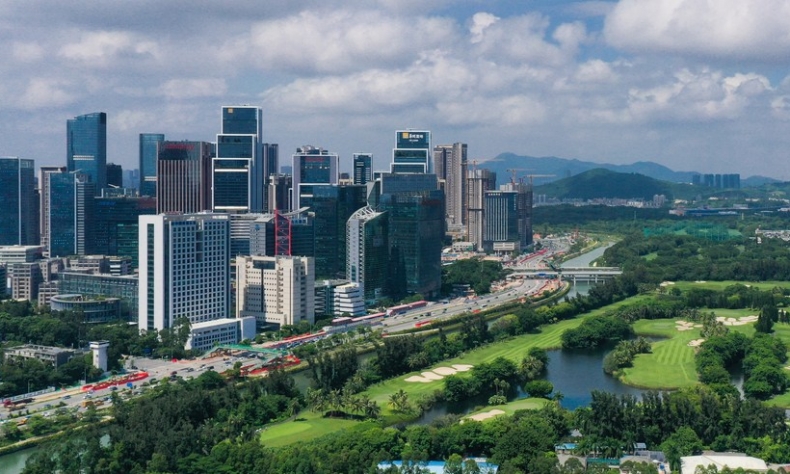A Unified Market over Uneven Development

The call for an accelerated move to build a unified national market essentially unmasked stumbling blocks to free movement of resources such as goods, people, and ideas in the domestic market.
Over the years, China has achieved top market positions in a wide range of spheres including smartphones, e-commerce, semiconductor equipment, and new-energy vehicles, rendering the appeal of its domestic market a key element of its economic prowess.
Hence, the sheer size of the mega market—amplified by a rather complete industrial system—is often cited as a default setting of the world’s second largest economy.
The quantity-oriented focus of China’s domestic market has recently enjoyed a high-profile upgrade, perhaps the highest in decades, in a courageous and elusive attempt to maximize market potential in a haze of uncertainty both at home and abroad.
In a late-night announcement on a Sunday in April, the Communist Party of China (CPC) Central Committee and the State Council, the cabinet, unveiled guidelines to accelerate building a unified national market, appropriately four months after the ordinance was reviewed and approved at a meeting of the Central Committee for deepening overall reform in mid-December.
The wide-ranging guidelines eye breaking local protection and market fragmentation and removing barriers impeding domestic flows of goods, services, capital, and labor.
The top-level guidelines instantly made headlines, shining an unprecedented spotlight on the weak links in an almost invincible market famed for its enormity and vitality.

Why system upgrade?
The call for an accelerated move to build a unified national market essentially unmasked stumbling blocks to free movement of resources such as goods, people, and ideas in the domestic market.
In a question-and-answer published shortly after the guidelines were unveiled, the official Xinhua News Agency said that the push for a unified domestic market has made significant headway in recent years, but some issues continue to keep the country from achieving a unified national market.
Citing an exclusive interview with an unidentified official with the National Development and Reform Commission, the country’s top economic planner, the Xinhua report enumerated market fragmentation and local protection, as well as market regulation rules, standards, and procedures that have yet to be unified.
Describing the market as the scarcest resource in today’s world, the report traced the unified market push back to the Third Plenary Session of the 18th CPC Central Committee in November 2013. The key plenum concluded that the building of a unified and open market system with orderly competition would lay the necessary groundwork for the market to play a decisive role in resource allocation.
Apparently, a unified market is by no means a new concept.
In a research note circulated in late April, Cheng Shi and Xu Jie, economists with ICBC International, derived the phrase from the Third Plenary Session of the 14th CPC Central Committee in 1993, also a milestone in the country’s economic policymaking.
The key session that formally endorsed the country’s socialist market economy envisioned breaking segmentation and blockage between regions and departments, quelling unfair competition, fostering a competitive environment, and forming a unified and open market through orderly competition.
As the economists pointed out, the government has long pursued the creation of a unified domestic market.
The fact that the guidelines tailored for the vision weren’t unveiled until nearly 30 years after the proposition first appeared in the momentous Party statement arguably speaks volumes about the arduousness of unifying a market as big as China’s.
Speaking via video at a seminar on government and market economics in late April, Huang Qifan, former mayor of Chongqing and an influential voice in the Chinese economy, said that China’s ultra-large single market with nearly 20 percent of the world’s total population, coupled with its complete manufacturing system, has nurtured unparalleled competitiveness in its factory sector. The country, therefore, exerts a huge impact on global supply and demand.
For years, China has gradually become more and more known for its gigantic single market, but at the same time some weak links in the market have become increasingly glaring.
Rivalries among regions over economic growth and scale have been attributed as an inherent engine for the economy’s continued rapid growth. Such competition also reverberates negatively however, when local governments compete to start new projects. Consequently, massive overcapacity has emerged, according to Huang. Local governments’ inclination to protect local businesses and even outdated capacity has exacerbated the overcapacity issue.
An urban-rural dual structure with labor migration between different parts of the country still subject to the restraints of the household registration system, as well as a separated land market between the rural and urban regions, among other aspects of imbalanced development, were cited as other weak links.
The planned economy mentality has been stifling in areas such as energy where the market has yet to place a decisive part in allocation of resources, Huang said, adding that different regions opt for different policies when it comes to market access in certain fields. A company can be registered in one place but not allowed to do so somewhere else.
Moreover, unchecked expansion of capital in real estate, finance, and internet sectors has stoked woes over market monopolies, according to Huang, pointing to a crucial overhaul of the Chinese market.
Mounting economic challenges in recent years such as the China-U.S. trade war and economic fallout from the COVID-19 have likely heightened the need for the country to build a unified market faster.
When the economy was growing briskly, issues with local governments’ excessive focus on GDP and local tax revenues and the prevalence of local protectionism often went unaddressed, said chinanews.com in an article in mid-April, citing Zhu Keli, executive director of the China Institute of New Economy.
Local governments have also tended to champion local businesses and brands and in turn set up either visible or hidden obstacles to discourage the foray of non-local firms, Zhu said.
Such problems have risen to the surface amid downward pressure on the economy, he continued. Consequently, fluctuations in trade terms and manufacturing and operating challenges facing the business community are underlining the imperative necessity of a unified market.
It is becoming increasingly imperative for the country to establish a unified national market in the face of global economic slowdown and the still-raging pandemic, said Yang Delong, chief economist at Shenzhen-based First Seafront Fund Management Co.
The economist expressed hope that unified rules and standards would result in a substantial increase in market efficiency.

Unified blueprint
The new guidelines are in essence interwoven with another buzz phrase in China’s economic retool.
As part of efforts to shield the economy from an increasingly mercurial external environment, the country’s leadership proposed the “dual circulation” strategy in May 2020.
The two-pronged strategy has since anchored the economy toward a new development paradigm which eyes the domestic market, or internal circulation, as the mainstay. Meanwhile, the economy remains open to the overseas market—external circulation.
The implicit reorientation toward the domestic market apparently precipitates the rollout of the long-awaited guidelines for the market to shift from big to strong.
The far-reaching guidelines in April encompass property rights protection, market access, energy, technology, land, and labor markets, shining light on how the economy plans to redesign its market apparatus.
The ordinance apparently seeks to troubleshoot weak links and prompt cleanup of policies that hamper a unified market and fair competition through local protection, market segmentation, and designated deals. Varied preferential policies that discriminate against foreign businesses and non-local firms will be sanitized while new policies will have to pass fair competition screening.
Describing the guidelines as a “consequential guiding paper” to break regional separation and allow a coordinated push for deeper reform and wider opening-up, Yang was upbeat about sustainable economic development in the guidelines’ wake.
To achieve a unified domestic market, the country will improve its property rights protection system to ensure a unified and regulated law enforcement and juridical regime for lawsuits concerning property rights disputes. Cross-regional jurisdiction over intellectual property rights (IPRs) will be improved to straighten out IPR litigation, arbitration, and mediation, according to the guidelines.
Furthermore, a unified market access system will be implemented with a nationwide negative list of prohibited and restricted sectors. Local governments and bodies are banned from issuing their own negative lists that delineate market access.
Furthermore, a unified mechanism for fair competition would be safeguarded, with an improved regime for fair competition-enabled policy implementation. The guidelines also promise revision of the country’s antitrust law and anti-unfair competition law.
A unified social credit system that covers all of society, all categories of credit information, and all parts of the country will also be formed.
As such, the guidelines map out a unified market over the long term, touching on industries ranging from energy and traditional infrastructure to logistics, big data, and emerging technologies such as facial recognition, fingerprinting, and iris scans.
Planned measures to unify the national energy market include improving availability of a unified natural gas measuring and pricing system, building a national electricity trading center, and honing a unified national coal trading market.
Such efforts will surely make a difference for the country that still has lingering fears over coal supply shortages, which ravaged much of the country last year. Increased awareness about energy security amid the Russia-Ukraine tension is only increasing the urgency of the need for energy market allocation at a national level.
Flow of capital across a unified single market was also mentioned in the unified strategy that pledged to “install red and green lights for capital and prevent the disorderly expansion of capital.”
In remarks at the 2022 Tsinghua PBCSF Global Finance Forum in Beijing in mid-April, Xue Lan, dean of Schwarzman College at Tsinghua University, explained that capital would head toward destinations with highest profit returns and naturally flow into areas with both sound earnings in economic and social terms.
For areas with decent social benefits but lagging in comparison to other more economically rewarding spheres, green lights should be installed to encourage capital flow into these areas, Xue went on to say. Conversely, red lights ought to apply to areas with fat returns yet substantial social impact.

Thorny road
While the comprehensive vision intends to remedy most of the recurring headaches haunting the Chinese market, concerns remain over how effective the plans will be in terms of genuinely achieving a unified domestic market.
For starters, worries remain over how much government oversight a unified domestic market would require to function efficiently.
“Fundamentally speaking, obstacles impeding China’s unified market should be addressed by the system of administrative intervention in the market,” said Lu Ming, an economics professor at Shanghai Jiao Tong University, at a mid-May China Macroeconomy Forum webinar, as quoted by South China Morning Post.
“Only rule of law will really break the administrative monopoly,” Lu stressed.
With no timetable for the grand goal, the unified market strategy has been interpreted as a creed of dos and don’ts, rather than a legally binding decree that would penalize individuals, businesses, institutions and government bodies in violation.
To ensure guideline implementation, a system of incentives and disincentives is being planned, with rewards for regions delivering remarkable results in constructing a unified domestic market.
Meanwhile, a checklist of problematic and inappropriate interventions will be published in a dynamic manner. Establishment of a system that circulates typical cases and summons violators to make rectifications is also on agenda.
No specifics were provided concerning rewards or punishments.
Additionally, plans were revealed to set up a cross-departmental coordination mechanism headed by the NDRC and the State Administration for Market Regulation.
Measuring implementation of the unified market proposition in provinces and cities and gauging the performance of local governments may be a difficult task, so gauging progress on the proposition will likely be difficult.
If local governments can’t sufficiently be incentivized into or dissuaded from the unified market dos and don’ts, they could possibly just pay lip service to the vision.
Under the strategy, local governments are urged to prevent vicious competition to woo investment with encouragement to rely on “premium institutional supplies and innovation” to attract more investment from select firms.
After decades of uneven development across the country, it is often easier for developed regions to make institutional innovation than their less developed peers.
In any event, the country has proven to be astutely prepared to rearrange its astronomical market, however bumpy the road ahead.
 Facebook
Facebook
 Twitter
Twitter
 Linkedin
Linkedin
 Google +
Google +










